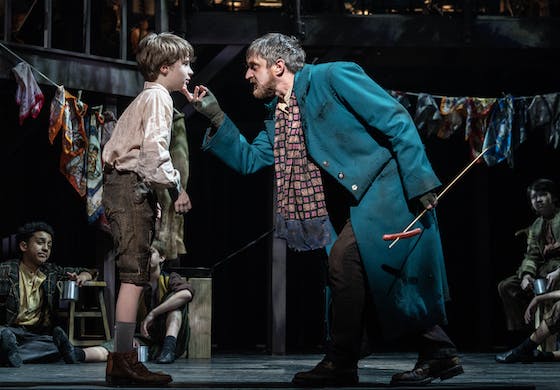Bigger Than the Beatles? ‘Oliver!’ Gets Its Encore
Directed by Lear Debessonet, this production re-established the show’s status as one of the more irresistible works of world musical theater.

We remember the major dates of pop music history as if they were epic battles: the “Rhapsody in Blue” had its premiere on February 12, 1924 (fasten your seatbelts for a big centennial); Benny Goodman brought jazz to Carnegie Hall on January 16, 1938; and “Oklahoma!” changed the course of musical theater, and much of everything else, on March 31, 1943.
Then, on February 9, 1964, the Beatles made their American debut on “The Ed Sullivan Show,” and thus brought about both the British Invasion and the second coming of rock-and-roll. Yet though the Fab Four were already a very big deal by that time, that particular episode was also eagerly watched by an entirely different segment of the population because of another U.K. import.
Based on one of the masterpieces of English literature, “Oliver Twist” by Charles Dickens, “Oliver!” had opened successfully on the West End in 1960, then on Broadway three years later, and was first seen on American TV on that same February 9, 1964, Sullivan show. At that moment, “Oliver!” was probably bigger than the Beatles: The show broke all records in London, then ran for several years in New York, and then the 1968 film version became one of the major blockbuster movie musicals — winning six Oscars, no less — during a period when other big-budget stage adaptations, like “Hello Dolly,” “Paint Your Wagon,” and “Camelot,” were tanking left and right.
“Oliver!” has continued to be a beloved work on the West End, but never again in New York, except for a one-month limited run in 1984 that featured Patti LuPone. It was a perfect candidate for City Center Encores! in that it is a great show that’s never been fully revived on Broadway. One hurdle was that Encores traditionally had a mandate to present only American works; thankfully, it relaxed that rule, for this occasion at least, and also doubled its usual run for these semi-staged productions to two weekends.
Two weekends — nine performances — was hardly enough. Directed by Lear Debessonet, this production re-established the show’s status as one of the more irresistible works of world musical theater, opening with a dark prologue that suggests “Sweeney Todd” and later a chorus of dancing moppets that anticipates “Annie.” The most successful of the Dickens musicals, including the dozens of “Christmas Carol” adaptations, “Oliver!” is that rare show, like the best of Rodgers & Hammerstein and Lerner & Loewe, where every song is absolutely priceless; there’s nothing in the entire score that isn’t worth humming.
It was, in fact, the musicalization of “Oliver Twist,” and the latest production especially, that brought us the reformation of the character Fagan. He’s very much a bad guy in the novel, if not quite as satanic as the demon burglar Bill Sykes. That’s changed in the 20th century: When Alec Guiness played Fagan in the classic 1948 David Lean film (opposite Robert Newton, the archetypical movie pirate, as Sykes), he made him more comic and sympathetic.
As played by the disarming Raul Esperanza here, Fagan is, more than ever, a figure of fun, and in the first act especially, almost a hero. Indeed, he’s virtually the only adult not shown abusing young boys; he turns them into crooks and makes them do his evil bidding, yes, but he treats them kindly.
It’s in the second act that the villains get more villainous, where Sykes (Tam Mutu) and Fagan contrive to kidnap Oliver in order to save their own skins. Fagan’s songs, “You’ve Got To Pick a Pocket or Two” and “Reviewing the Situation,” utilize a narrative form and semitic-sounding minor chords that anticipate Tevya’s musical monologues in “Fiddler on the Roof” four years later. At City Center, Fagan even dances in front of the orchestra after the curtain call, in what seems like the theatrical equivalent of a Marvel movie post-credit sequence.
Lili Cooper, daughter of the estimable baritone Chuck Cooper, delivers a great turn as Nancy; she gets two of the biggest, full-chorus numbers, “It’s a Fine Life” and “Oom-Pah-Pah.” The latter has been described by historian Laurence Maslon as a cockney “tankard-clanker” in the tradition of “With a Little Bit of Luck” from “My Fair Lady.” Nancy also delivers the big ballad and torch song, “As Long as He Needs Me,” the only number in the excellent score to become part of the pop bloodstream. Two other Broadway vets, Brad Oscar and Mary Testa, have many a memorable moment together as Mr. Bumble and Widow Corney.
Then there’s the Artful Dodger, which leads me to a question that may necessitate the pleasant task of re-reading Dickens. A pickpocket is supposed to be all but invisible and blend into the scenery, right? So why does the Dodger dress like a circus ringmaster, with a Willy Wonka coat and a towering top hat?
Never mind, the role, well played by Julian Lerner, has always been a starmaker: Anthony Newley was the Dodger in 1948, and in both London and New York, the original musical Dodger was Davy Jones, later with the Monkees, and thus a highly appropriate individual to share the billing with the Beatles.

